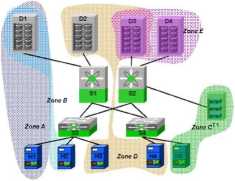9818247274
SAN Security Protocols and Mechanisms
3.3 Access Control and Authentication
Another critical aspect of SAN security is authorization and authentication, controlling who has access to what within the SAN. Currently, the level of authentication and authorization for SANs is not as detailed and granular as it should be. Most security relies on measures implemented at the application level of the program reąuesting the data, not at the storage device, which leaves the physical device vulnerable. Moving SAN Communications to IP-based networks makes it even morę exposed and vulnerable to attacks madę on corporate networks, such as device identity spoofing. Each of the technologies, like iSCSI as well as FC or FCIP has its own mechanisms of how to address the remote node authentication reąuirements or it rely on other protocols such as IP Security protocol (IPsec) 4 SAN Security Mechanisms
The basie rules of security also apply to SANs. Just because the technology is relatively new, the security principles are not. First, SAN devices should be physically secured. This was relatively simple to accomplish when SANs existed mainly in well-protected datacenters. But as SANs grow morę distributed and their devices sit in branch office closets, physical security is tougher to guarantee. On top of that, each of the protocols mentioned so far has its own subset of security mechanisms.
4.1 Securing FC fabric
By itself, Fibrę Channel is not a secure protocol. Without implementing certain security measures within a Fibrę Channel SAN, hosts will be able to see all devices on the SAN and could even write to the same physical disk! The two most common methods of providing logical segmentation on a Fibrę Channel SAN are zoning and LUN (Logical Unit) masking.
4.1.1 Zoning
Zoning is a function provided by fabric switches that allows segregation of a node in generał by physical port, name or address. Zoning is similar to network VLANs (virtual LANs), segmenting networks and controlling which storage devices can be accessed by which hosts. With zoning, a storage switch can be configured for example to allow host HI to talk only with storage device Dl, while host H2 could talk only to storage device D2 and D3, like it is illustrated in Exhibit 9.

Exhibit 9: FC Zoning Example
Wyszukiwarka
Podobne podstrony:
SAN Security Protocols and Mechanisms 10 networks, allowing a commodity IP network to function in a
SAN Security Protocols and Mechanisms 12 One host or storage device could also belong to a multiple
SAN Security Protocols and Mechanisms 13 4.1.3 Fibrę Channel Security Protocols To address additiona
SAN Security Protocols and Mechanisms 14 4.1.3.1.2 Fibrę Channel Authentication Protocol Fibrę Chann
SAN Security Protocols and Mechanisms 15 4.1.3.2FC-SP per frame confidentiality and integrity Recogn
SAN Security Protocols and Mechanisms 16 FC-2 Payload: 0-528 Transmission
SAN Security Protocols and Mechanisms 17 • Data Origin Authentication The IPsec re
SAN Security Protocols and Mechanisms endpoints can be determined, the true source and destination e
SAN Security Protocols and Mechanisms 19 An iSCSI node must also support Internet Key Exchange (IKE)
SAN Security Protocols and Mechanisms_2_ Storage Area Networks Security Protocols and Mechanisms Ind
SAN Security Protocols and Mechanisms 20 6 Futurę directions Storage security is still evolving topi
SAN Security Protocols and Mechanisms Index of Exhibits Exhibit 2: NAS
SAN Security Protocols and Mechanisms Storage Area Networks Security Protocols and Mechanisms 1 Intr
SAN Security Protocols and Mechanisms Storage or shortly NAS. NAS architecture consist of a dedicate
SAN Security Protocols and Mechanisms The invention of a Fibrę Channel (FC) has opened a complete ne
SAN Security Protocols and Mechanisms iSCSI enables SCSI-3 commands to be encapsulated in TCP/IP pac
SAN Security Protocols and Mechanisms Exhibit 6: Fibrę Channel Protocol Stack The lowest level (FC-0
SAN Security Protocols and Mechanisms FCIP transports Fibrę Channel data by creating a tunnel betwee
SLT, Prescribed books Student* leatł tutnriah - Fwfjnotion: Tutonal 1: Rcvise and clarify a gicn asp
więcej podobnych podstron